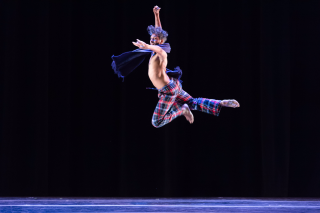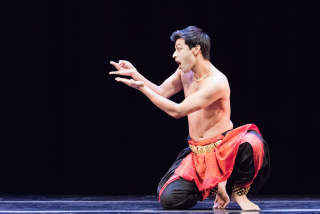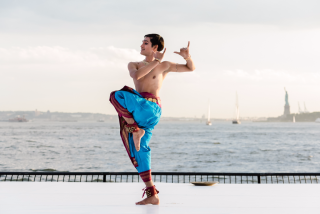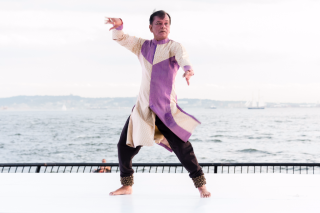
| Erasing Borders Dance Festival Indo-American Arts Council | |
| Schimmel Center for the Perfoming Arts (Indoors) New York, NY August 13, 2016 Wagner Park (Outdoors, as part of the Battery Dance Festival) New York, NY August 15, 2016 |
|
| by Leigh Witchel copyright © 2016 by Leigh Witchel |
|
 |
|
| The heat gave sweltering Indian realness to the Indo-American Arts Council's “Erasing Borders” dance festival. Performances took place on two days, and if Saturday's indoor concert was more climate-controlled, Monday's had the consolation of a sunset view past the southern tip of Manhattan to the Statue of Liberty and Ellis Island. Both performances were a mix of traditional Indian dances and fusion pieces – all interesting, though sometimes for what succeeded and what didn't. Sooraj Subramanian in “Nocturne.” Photo © Darial Sneed. Choreographers have seen a mix of Indian and Western classical dance as fertile ground for decades, at least since 1944 when La Meri created a version of “Swan Lake.” (Too bad “La Bayadère” wouldn't be known in the West for another 20 years; to this day no classical ballet seems riper for re-appropriation). Eriko Sugimura – in collaboration with Ram Sampath and Shreenath Muthyala presented “Padam” (a type of passionate song) . Amid votive candles on a dim stage, Sugimura, in a patrician tulle skirt bejeweled with crystal ornaments on her ankles and hands, as well as in her hair, danced ballet steps depicting the most elemental convention of an Indian solo – someone awaiting an inattentive lover. Usually the object of desire remains unseen to the audience, here he was in effigy at the front of the stage. Sugimura did strong, clean arabesques punctuated by Indian hand gestures, developpé extensions and Indian charka turns ending in attitude. But the choreography, classroom exercises meandering from one step to the next without an overlying structure, didn't live up to the idea. Cynthia Ling Lee's “rapture/rupture” ranged far afield of classical bharatanatyam; taking the traditional abhinaya mime and filtering it through a post-modern lens. Discarding her veil, tunic and jewelry for jeans and fedora, she recited her own poetry. At first it was simple declarations (“Beloved, our love was not enough”) but then veered into jargon (“erupt with otherness”). Bharatanatyam gets its meaning from abhinaya, but its excitement from the nritta: the high-speed bursts of pure virtuosity. Ling Lee's mime was bogged down in conceptualizing, and the piece had no nritta. It kept the experiment from rising beyond a lecture and becoming compelling enough to explode the form. |
|
 |
|
| Suraj | |
| Subramaniam's “Nocturne” managed exactly that. Born in Malaysia, trained in Australia and London, now working in Belgium, his deft mix of contemporary and classical work recalled both Akram Khan and Aakash Odedra. Subramaniam took a universal event – a sleepless night – but instead of intellectualizing it, kept piling on one detail after another that we could identify with, and then linking them back to the classical form. | |
| Shirtless, wearing loose pajama pants in a bright Madras plaid, Subramanian tossed on the floor. A purple shawl served as a blanket; he sat up, scratched himself, and used his hand to prop up his sagging face. Finding himself alone at night with selections of pop and Carnatic music as his only companions, he seemed to be sleepwalking in a discotheque. In mischievous stroke of realism, he did what people do when they get up in the middle of the night – relieved himself. He walked to the back of the stage and stood facing back. An audience attuned to Indian dance understood the new mime gesture: one involving flushing. He washed his hands afterwards with elaborate swirling motions. There was dance as well: kathak stamps, charkas and western floor work. The convention of the waiting lover appeared again in the final part of “Nocturne” – we’d see it more before the night ended. But at the close, the invisible lover finally did arrive. You didn't realize how subversive “Nocturne” was until you were well into it, and it managed it all with perception and humor. |
|
| Revanta Sarabhai has bharatanatyam in his blood; he’s the son of famed performer Mallika Sarabhai. He also found a way to tweak his heritage affectionately. “Maanvizhi Kannavale” was also a padam, but a modern one that Sarabhai wrote in English about a long-distance relationship, had translated into Tamil and set to music. Dressed in traditional red and black pants and gold jewelry, Sarabhai stamped rhythmically to a song that referenced both Lord Krishna and Skype. The updates were treated casually; Sarabhai mimed the same way he would act out playing with a ball or shooting an arrow – except he was talking on a cell phone or slamming a laptop shut. And yet, how different was his frustration from a thousand years ago? It looked much the same as in the most famous Indian love poem, when Radha was furious at Krishna for being unavailable . . . and melted at his sight when he finally turned up. When Sarabhai’s invisible partner (we knew from the poem it was a woman) turned up at the door, he embraced her and galloped off. Rama Vaidyanathan is a vet who has the chops to show off. Indian dancers practice abhinaya as methodically as ballet dancers do pliés and tendus. “Navarasa Mohana” expanded an exercise of nine emotions usually portrayed in rapid succession, but here expanded and punctuated with pure dance episodes. After gliding and stamping side-to-side, Vaidyanathan returned to center stage and transformed into a thundering warrior or a love-struck girl, until she ended with a walk forward where each of the nine personas melted into the next, revealing the germ that created the pearl. |
|
 |
|
| Rather than the direct comments on gender during the evening, some of the most interesting dynamics came from both Vaidyanathan and Avijit Das, who performed a straight kuchipudi solo, “Dashavatara Shabdam.” It was interesting was to see how similarly a woman and a man attacked abhinaya. Lightness and weight were used much the same way. Indian mime certainly involves conventions of gender, but more in portrayal than performance: a woman is shown as soft and curved; a man is indicated with straight lines and often with his weight back. But both a male and female dancer make the exact same distinctions when acting. | |
| On Monday in the liquefying heat, instead of contemporary fusion, Subramanian performed “Sthai,” a solo in traditional Odissi style. The discipline, which accentuates a S-shaped posture more than the vertical spine of bharatanatyam, seemed a natural fit for the way he moved: all soft curves, bobbing on top of the rhythm like a cork. Subramanian found stillness in the speed, taking a section of rapid fire patter and instead of moving faster, slowing down and posing. | |
| Das performed at both concerts as well, but perhaps because he was pinch-hitting Saturday for another artist, we saw him at his best on Monday. “Tarangam” showed off his nature in a way “Dashavatara Shabdam” didn't. To use ballet terms, Das is a petit allegro dancer: lithe and wiry, with speed, line, and a high center of gravity that seemed to float even when he was heading down into a knee bend. “Dashavatara Shabdam” made him look lightweight instead of like a speed demon. In “Tarangam,” he showed off his musicality and attack, moving from side to side during the tongue-twisting patter, finally stopping in attitude front and passing through a stable grand rond de jambe to the back. | |
 |
|
| The Old School highlight of the outdoor concert was Pandit Krishan Mohan Mishra's kathak improvisation in the Lucknow style, which featured three talented musicians. He put them through a nerve-wracking workout as they followed his stamps and gesticulations in an ever-twisting chain of complexity, placing the microphone on the floor and slamming his feet like thunder. The best was when he demonstrated the same agility by raising each eyebrow alternately in varying rhythms. “It's very difficult,” he remarked in a humblebrag. Mishra didn't dance to create structure, or even primarily movement. Like his soul cousin, Savion Glover, he created rhythms and beats, and we were not there as an audience, but observers. “Erasing Borders” has always been an apt name for the festival. Indian dance in the U.S. gives us a glimpse into a community of visitors, immigrants, expatriates and those with no ties to India except a love of the form. The exchange has been integral. As with the Americans who went to Europe a century ago to broaden their horizons, is this part of the evolution of dance and the arts in India? copyright © 2016 by Leigh Witchel All photos © Darial Sneed Second: Revanta Sarabhai in “Maanvizhi Kannavale” Third: Sooraj Subramanian in “Sthai” Fourth: Avijit Das in “Tarangam” Fifth: Pandit Krishan Mohan Mishra |
|
| URL: http://www.danceviewtimes.com/2016/08/the-cosmopolitans.html | |